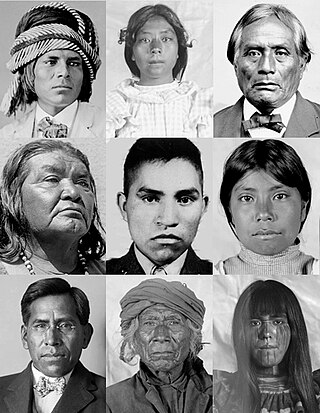Related Research Articles

Polka is a dance style and genre of dance music in 2
4 originating in nineteenth-century Bohemia, now part of the Czech Republic. Though generally associated with Czech and Central European culture, polka is popular throughout Europe and the Americas.

Brave Combo is a polka fusion band based in Denton, Texas. Founded in 1979 by guitarist/keyboardist/accordionist Carl Finch, they have been a prominent fixture in the Texas music scene for more than thirty-five years. Their music, both originals and covers, incorporates a number of dance styles, mostly polka, but also some Latin American and Caribbean styles like norteño, salsa, rumba, cha-cha-cha, choro, samba, two-step, cumbia, charanga, merengue, ska, etc, all performed with a rock/worldbeat energy.

James W. Sturr Jr., commonly known as Jimmy Sturr, is an American polka musician, trumpeter, clarinetist, saxophonist and leader of Jimmy Sturr & His Orchestra. Media outlets have often dubbed him the "King of Polka," with his recordings having won 18 out of the 24 Grammy Awards given for Best Polka Album. Sturr's orchestra is on the Top Ten List of the All-Time Grammy Awards, and has acquired more Grammy nominations than anyone in the history of musical polka awards.

The Tohono Oʼodham are a Native American people of the Sonoran Desert, residing primarily in the U.S. state of Arizona and the northern Mexican state of Sonora. The United States federally recognized tribe is the Tohono Oʼodham Nation. The Ak-Chin Indian Community also has Tohono O'odham members.
Switzerland has long had a distinct cultural identity, despite its diversity of German, French, Italian, Romansh and other ethnicities. Religious and folk music dominated the country until the 17th century, with growth in production of other kinds of music occurring slowly.

The Akimel O'odham, also called the Pima, are a group of Native Americans living in an area consisting of what is now central and southern Arizona, as well as northwestern Mexico in the states of Sonora and Chihuahua. The majority population of the two current bands of the Akimel O'odham in the United States are based in two reservations: the Keli Akimel Oʼodham on the Gila River Indian Community (GRIC) and the On'k Akimel O'odham on the Salt River Pima-Maricopa Indian Community (SRPMIC).
The music of the Virgin Islands reflects long-standing West Indian cultural ties to the island nations to the south, the islands' African heritage and European colonial history, as well as recent North American influences. Though the United States Virgin Islands and British Virgin Islands are politically separate, they maintain close cultural ties. From its neighbors, the Virgin Islands has imported various pan-Caribbean genres of music, including calypso music and soca music from Trinidad and reggae from Jamaica.

Norteño or Norteña, also música norteña, is a subgenre of regional Mexican music. The music is most often based on duple and triple metre and its lyrics often deal with socially relevant topics, although there are also many norteño love songs. The accordion and the bajo sexto are traditional norteño's most characteristic instruments.

Music in the United States underwent many shifts and developments from 1900 to 1940. The country survived both World War I and the Great Depression before entering World War II in December 1941. Americans endured great loss and hardship but found hope and encouragement in music. The genres and styles present during this period were Native American music, blues and gospel, jazz, swing, Cajun and Creole music, and country. The United States also took inspiration from other cultures and parts of the world for her own music. The music of each region differed as much as the people did. The time also produced many notable singers and musicians, including jazz figure Louis Armstrong, blues and jazz singer Mamie Smith, and country singer Jimmie Rodgers.

Austrian folk dancing is mostly associated with Schuhplattler, Ländler, polka and waltz. However, there are other dances such as Zwiefacher, Kontratänze and Sprachinseltänze.
Banda is a subgenre of regional Mexican music and type of ensemble in which wind and percussion instruments are performed.
Ofelia Zepeda is a Tohono O'odham poet and intellectual. She is Regents' Professor of Tohono O'odham language and linguistics and Director of the American Indian Language Development Institute (AILDI) at The University of Arizona. Zepeda is the editor for Sun Tracks, a series of books that focuses on the work of Native American artists and writers, published by the University of Arizona Press.

Polka is a music and dance style that originated in Bohemia in the 1830s and came to American society with immigrants from Europe. A fast style in 2
4 time, and often associated with the pre–World War II era, polka remains a dynamic niche music in America.

The Tohono Oʼodham Nation is the collective government body of the Tohono Oʼodham tribe in the United States. The Tohono Oʼodham Nation governs four separate sections of land with a combined area of 2.8 million acres (11,330 km2), approximately the size of Connecticut and the second-largest Indigenous land holding in the United States. These lands are in the Sonoran Desert of south central Arizona and border the Mexico–United States border for 74 miles (119 km). The Nation is organized into 11 local districts and has a tripartite system of government. Sells is the Nation's largest community and functions as its capital. The Nation has about 34,000 enrolled members, most of whom live off of the reservations.

The Tohono Oʼodham Indian Reservation, is an Indian reservation of the Tohono Oʼodham Nation in Arizona, United States. The reservation had a 2020 census population of 9,561. It has an area of 4,340.984 square miles (11,243.098 km2), 97.48 percent of the Tohono Oʼodham Nation's total area. The reservation encompasses parts of central Pima, southwestern Pinal, and southeastern Maricopa Counties.

Liscio or ballo liscio is a genre of music originating in the 19th century in the northern Italian region of Romagna under the influence of Viennese ballroom dances including the mazurka, waltz, polka, schottische, march. It later became popular and spread to the rest of the country. The accordion, which was also a 19th-century invention, features prominently. The tradition contrasts with older Italian folk dances in which the fiddle was the primary instrument.
Tucson, Arizona has a strong, growing independent music culture that focuses on locally grown and locally derived musical genres. The city is home to musical organizations that seek to nurture artists from the local music scene as well as introduce the community to other musical styles from beyond Southern Arizona.

Tohono O'odham Community College (TOCC) is a public tribal land-grant community college in Haivana Nakya, Arizona. As of fall 2023, TOCC's student body was 96 percent American Indian/Alaskan Native. Tohono O'odham Community College serves approximately 1174 students. As of 2012, the college's faculty and staff was 57 percent American Indian, half of whom were O'odham.
Arthur J. Hubbard Sr. was an American state senator from Arizona, who served as a Navajo Code Talker instructor in World War II.
Chicken scratch may refer to:
References
- ↑ "Waila: Chicken Scratch". Pulse of the Planet. Archived from the original on March 10, 2005. Retrieved June 21, 2005. Pulse of the Planet also mentions cumbia as a more recent influence
- ↑ "Accordion Music". Music of the Southwest. Archived from the original on May 24, 2005. Retrieved June 21, 2005.
- 1 2 Pulse of the Planet
- 1 2 3 "The Annual Waila Festival". Library of Congress: America's Story. Archived from the original on June 24, 2005. Retrieved June 21, 2005.
- ↑ "Le chant des Indiens d'Amérique du Nord". La Médiathèque. Archived from the original on October 20, 2005. Retrieved June 21, 2005. (in French)
- 1 2 Means, Andrew. "Hey-Ya, Weya Ha-Ya-Ya!". 2000. In Broughton, Simon and Ellingham, Mark with McConnachie, James and Duane, Orla (Ed.), The Rough Guide to World Music, Rough Guides Ltd, Penguin Books. p. 594. ISBN 1858286360
- ↑ Southern Scratch. Archived March 21, 2009, at the Wayback Machine Canyon Records (23 April 2009)
- ↑ "Music Awards – Best Waila". Archived from the original on August 18, 2011. Retrieved August 13, 2011.